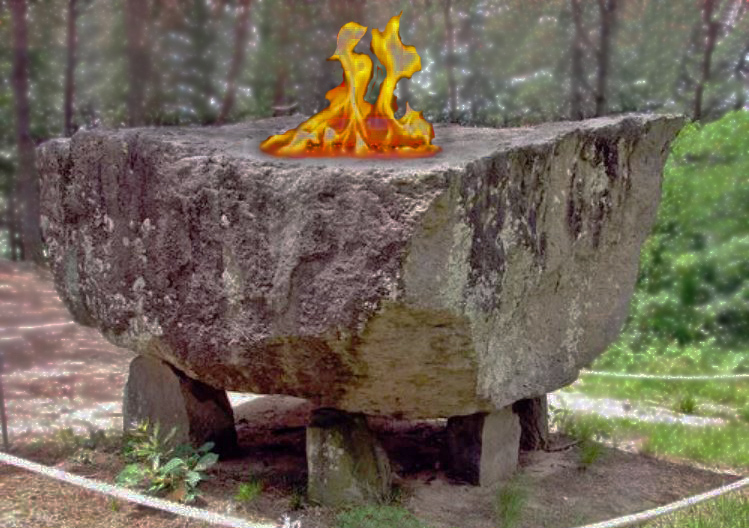Oahspe Study and Faithism
The Three Sacrificial Flames

Within the
profound wisdom of the Se'moin Tablet are three types of Flames atop altars.
They are in sequence, and each specific to a certain condition ---
Agni,
Gam and Woga.
Agni the Neutral Flame
Since the altar is the place of sacrifice, we may consider the sacrificial aspect of each flame. The sequence begins with AGNI, the Neutral Flame. This represents the conception of an idea, the inspiration. The light is received and sets the theme/motivation for inspiration which in turn primes the receiver for action.
Because the Agni Flame is neutral, so whatever we have built within our soul is illuminated and stimulated by the neutral flames of the ethereal fire. For that reason, for instance, many of the earth-bound spirits and mortals at the time of Sue perceived Agni according to their soul's orientation --- what the Oahspe authors called "Agni's just hate" (12/2.10); meanwhile the Faithists stood firm, aye, rejoicing because the time of deliverance was at hand.
Those responses occurred because the Agni Flame, being neutral, is able to penetrate all souls; and if any darkness lingers there, it gets illuminated which in turn triggers the accompanying fears of such a person.
Nonetheless, all inspiration direct or indirect comes from Jehovih and since Jehovih has "Given Himself All Away" and so engages in selfless service to uplift us, so the first sacrifice (here the Agni Flame) is from the Source and is offered by the Creator and given as food for the souls of His Creation. To the extent that we emulate our Creator, so do we partake of His Neutral Flame, Agni.
To approach the altar (whether physical or inner realm) so as to receive this inspiration most clearly, the beseecher must sacrifice or learn to sacrifice self (self-interests) so as to receive the selfless nature and inspiration of the neutral flame and thus be in a position to make wise choices about which path to take and how to engage it.
Oahspe, Book of Osiris; 18/6.18.
Consider now, O brothers! When the conscience of man burns inward, there is still darkness slumbering in his soul. The etherean lights will burn him. He whose conscience no longer burns inward, becomes himself a brilliant flame of light. Through him Jehovih speaks.
Gam the "Going Forth" Flame
The second Flame is GAM the "Going Forth" flame --- now no longer neutral since the option to act upon the inspiration has been taken up. And so in going forth along a path, other alternative trajectories are instantly eliminated. This is the sacrifice of Gam. By choosing one way, one sacrifices opportunities and fruits that would come from taking another path.
Once a person decides to go forth toward some end, so Jehovih provides either directly or indirectly, or both. As a consequence, the person in Gam rejoices in receiving the bounty of Jehovih's abundance. Such expression of the spirit is the sacrifice that comes from the fullness of one's soul. For those whose soul is more toward self, so such exuberance or gratitude or relief tends to be short lived compared to those who are upward aspiring and practicing their all-highest.
For, we all GO FORTH with what we have, however limited our orientation, talents and resources may be. Often enough we may act without consideration to consequences or alternatives which in turn stimulates us to develop caution, foresight and planning. The limits of our wisdom thus brings about what is sometimes called the "sin of omission", although that phrase often conveys only a narrow or specific interpretation.
Woga the Receptive Flame
Once we have gone forth and sown our path we begin to reap the returns. This is the beginning of WOGA, the Receptive Flame, the one that burns inward, while the GAM burns outward. (Agni is more an ubiquitous flame that manifests as Jehovih's Presence draws near.)
It is in repentance that we are able to rise beyond our shortcomings. If we had been in darkness, then under the light of the Woga Flame, we seek to make amends for past mistakes. If we had been in light practicing all light, then the Woga Flame concentrates to the foundation, perhaps giving rest or recreation, and perhaps simply a change of scenery or scenario and a time for rejuvenation.
Strange to say but delightful to contemplate is that Jehovih's redeeming hosts descend from etherea during their Woga times. In turn the presence of the ethereans' light awakens mortals to their own shortcomings. And these latter seek to rise so as to partake of the greater glories brought by the ethereans. In other words, man collectively undergoes Woga during times of Dan and to a lesser degree during times of rising light.
The wisdom of Jehovih in providing these different elements of light, allows man to attain to them in their higher aspects. In that regard, consider again the Tablet of Se'moin --- that bountiful foundational cornucopia of explanation regarding man's journey on earth. As Woga #74 follows Gam #73, which itself follows Agni #72, so #75 D'shom (Mountain or Mountaintop) follows #74 Woga. This signifies that until man learns to sacrifice in repentance (Woga), so he cannot rise to the heights (D'shon).
Oahspe. Book of Inspiration; 34/5.5,6.
And yet another feels My inspiration; and he skips up the mountainside, and does not tire on the way.
He who neither sees nor feels My inspiration, goes up the mountain in great labor.
May we all rise to the mastery of His lights, so that we too! may skip up the mountainsides of Jehovih's glories.
All Oahspe references are from the modern language edition: Oahspe Standard Edition 2007
GO TO
NEXT ARTICLE:
Fields of Man's Endeavor